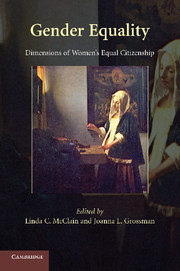Book contents
- Frontmatter
- Contents
- Contributors
- Acknowledgments
- Gender Equality
- Introduction
- PART I CONSTITUTIONAL CITIZENSHIP AND GENDER
- PART II POLITICAL CITIZENSHIP AND GENDER
- PART III SOCIAL CITIZENSHIP AND GENDER
- PART IV SEXUAL AND REPRODUCTIVE CITIZENSHIP
- 13 Sexual Citizens: Freedom, Vibrators, and Belonging
- 14 Feminism, Queer Theory, and Sexual Citizenship
- 15 Infertility, Social Justice, and Equal Citizenship
- 16 Reproductive Rights and the Reproduction of Gender
- PART V GLOBAL CITIZENSHIP AND GENDER
- Suggested Readings
- Index
- References
14 - Feminism, Queer Theory, and Sexual Citizenship
Published online by Cambridge University Press: 05 August 2012
- Frontmatter
- Contents
- Contributors
- Acknowledgments
- Gender Equality
- Introduction
- PART I CONSTITUTIONAL CITIZENSHIP AND GENDER
- PART II POLITICAL CITIZENSHIP AND GENDER
- PART III SOCIAL CITIZENSHIP AND GENDER
- PART IV SEXUAL AND REPRODUCTIVE CITIZENSHIP
- 13 Sexual Citizens: Freedom, Vibrators, and Belonging
- 14 Feminism, Queer Theory, and Sexual Citizenship
- 15 Infertility, Social Justice, and Equal Citizenship
- 16 Reproductive Rights and the Reproduction of Gender
- PART V GLOBAL CITIZENSHIP AND GENDER
- Suggested Readings
- Index
- References
Summary
The terms of full membership in society have, in the United States, as elsewhere, been conditioned on citizens conforming to a specific set of sexual norms. Some of these terms of sexual citizenship have been explicitly encoded into U.S. law. These have included, among many others, the historical ban on immigration of homosexuals, criminal proscriptions on the act of sodomy, the now rarely enforced bans on sex outside of marriage, and the still enforced criminal prohibitions on prostitution. Other sexual norms have largely been enforced extralegally through social sanctions. For example, the widespread disapproval of sex by unmarried women in the early twentieth century led to the ostracizing of unmarried pregnant women from polite society.
In the last few decades, the terms of sexual citizenship have undoubtedly changed. The U.S. Supreme Court boldly announced, in the landmark case of Lawrence v. Texas in 2003, that states could no longer criminalize sodomy, whether homosexual or heterosexual. Four state supreme courts have now struck down state laws banning same-sex marriage, and three of these states are now authorizing such marriages. In addition, three states, Maine, New Hampshire, and Vermont, recently adopted same-sex marriage legislatively. Almost all citizens now engage in sex before marriage, and most teenagers are sexually active. Furthermore, while women bearing children out of wedlock is still controversial, society is now far from a consensus that it is morally wrong.
- Type
- Chapter
- Information
- Gender EqualityDimensions of Women's Equal Citizenship, pp. 307 - 326Publisher: Cambridge University PressPrint publication year: 2009
References
- 2
- Cited by

